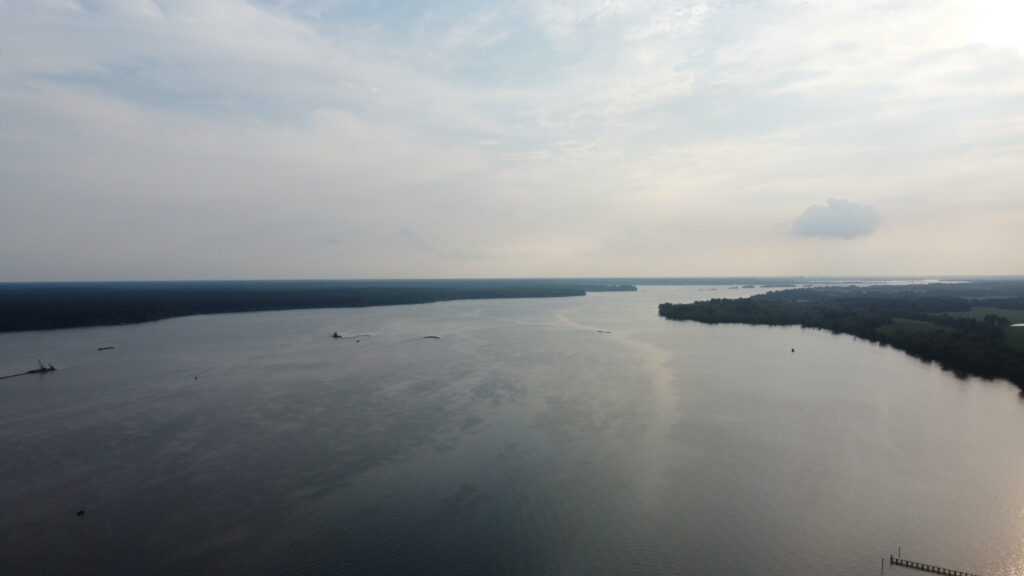An aerial photo of the James River. (Courtesy of Evan Visconti)
A new program that scientists have sought to make Chesapeake Bay clean up more effective is now underway in Virginia, following a budget allocation from the legislature this year.
Known as the Pay-for-Outcomes grant program, the Department of Environmental Quality (DEQ) is accepting applications by Feb. 3 for the $20 million that is available.
“We’re not reimbursing people for efforts, we’re only paying for outcomes,” said Jonathan Rak, chief policy Advisor at DEQ, which administers a wide range of water quality programs. “We’re really excited about that.”
Virginia is part of the Chesapeake Bay Program, a collection of the six states that are home to the waters of the 64,000 mile watershed feeding into The Bay, the nation’s largest estuary, which remains polluted after decades of efforts.
The Bay program has pledged to clean up the Bay by reducing nitrogen, phosphorus and sediment erosion entering waterways, primarily through adoption of storm and wastewater treatment facility upgrades and agricultural best management practices, called Ag BMPs. Those efforts reduce waste or rainwater runoff that carry nutrients into rivers and streams.
But the Bay Program is behind on meeting deadlines for 2025.
As several organizations, including the Chesapeake Bay Commission, U.S. Environmental Protection Agency, and state, environmental, local and farming groups discuss what the new goals should be and how to achieve them, the Pay-for-Outcomes program has gained attention as a way to get the most bang for a cleanups’ buck. Maryland adopted a program last year.
“New financial incentive programs such as pay-for-performance or pay-for-success programs,” wrote the Scientific and Technical Advisory Committee of the Bay program in a Comprehensive Evaluation of System Response 2023 report, “offer opportunities … to encourage adoption of highly effective practices that land managers may not consider under standard cost-share programs.”
The Bay Program has counted progress toward cleanup goals by relying on modeling from the adoption of the Ag BMPs.
Virginia has recently pumped record amounts of funding into a cost-share program to help with installing those BMPs, which include streamline fences to keep animals from defecating in waterways, or buffers to catch fertilizer before it trickles into streams and creaks, participation hasn’t been at desired levels.
Though the Ag BMP modeling is backed by scientific calculations, there isn’t a full verification to guarantee water quality is improving after a practice is installed. The Pay-for-Outcomes program is seen as a way to ensure actual results, while also exploring new technologies that can offer a targeted approach, said Joe Wood, a senior scientist with the Chesapeake Bay Foundation, an environmental group.
One example of a new technology is a bioreactor, which is essentially a wood chip pile that filters spring water through it. Monitoring water between the spring and the reactor, and then past the reactor, can show how effective the technology is and if certain springs are releasing levels of pollution into waterways at higher rates than others, Wood explained.
In parts of the Shenandoah Valley, which have higher rates of nitrogen loads from a wide range of sources, including agricultural land that can also release varying amounts of nutrients in different sections, the Pay-for-Outcomes program can incentivize the use of the reactors to hone in on where work is needed.
“That kind of fine scale is really key to making our programs efficient,” said Wood. “If something like 10% of the land accounts for 50% of the loads, and if you go work in the areas that are low loading, you might never really get to address the key places.”
Jim Riddell of the Virginia Cattlemen’s Association, which represents thousands of cattle producers across the commonwealth, said he wasn’t sure what the level of interest in the program among farmers would be, but that it is an “opportunity” to go along with the Ag BMP cost-share program.
“We see this as additional supplemental money that will be directed toward nonpoint pollution,” Riddle said. “It’ll be interesting to see who and what the applicants are.”
The program is wide open to municipalities, farmers, environmental groups and for-profit groups within the Chesapeake Bay watershed, which in Virginia includes the James River and areas north of it, for awards of up to $100,000 to $7 million.
Applicants can be groupings of projects, which eases the amount of review work the DEQ must do, Rak said, and most show they achieve pollution reductions beyond what is already required under statute and regulation.
Proposals will first be reviewed by a technical committee consisting of professors from Virginia Tech and the Virginia Institute of Marine Sciences chosen by DEQ Director Mike Rolband, that will determine a “confidence interval” for how likely the project will reach success since some of the proposed methods will be novel.
Then, a selection committee with members of the DEQ and the Department of Conservation and Recreation will choose participants based on a scoring criteria, largely looking at the cost effectiveness of the program. Also, along with the confidence interval, proposals will be selected based on “habitat and resilience benefits, readiness to proceed, local government coordination, the provision of long-term maintenance and applicability to locally impaired waters,” states the budget language proposed by Del. David Bulova, D-Fairfax.
Applicants will have up to five years to achieve their results, which must be presented through monitoring or known modeling calculations, like for buffers. Then, payment will be delivered.
“There likely will be projects that fail,” said Rak. “That’s the nature of a pilot program. But we’re going to learn from that.”

